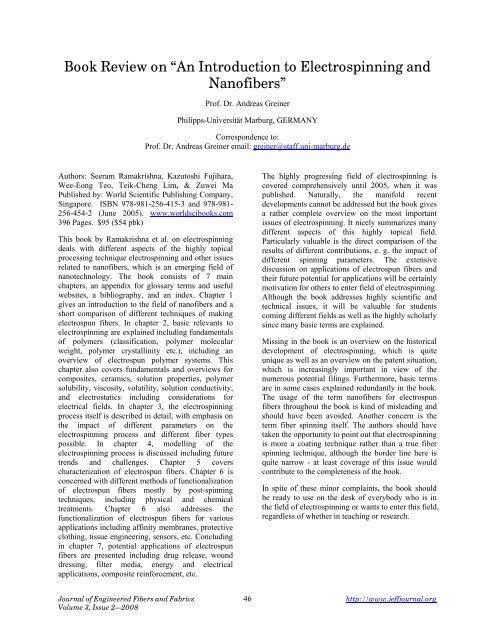An Introduction to Electrospinning and Nanofibers - JEFF. Journal of ...
An Introduction to Electrospinning and Nanofibers - JEFF. Journal of ...
An Introduction to Electrospinning and Nanofibers - JEFF. Journal of ...
You also want an ePaper? Increase the reach of your titles
YUMPU automatically turns print PDFs into web optimized ePapers that Google loves.
Book Review on “<strong>An</strong> <strong>Introduction</strong> <strong>to</strong> <strong>Electrospinning</strong> <strong>and</strong><br />
<strong>Nan<strong>of</strong>ibers</strong>”<br />
Pr<strong>of</strong>. Dr. <strong>An</strong>dreas Greiner<br />
Philipps-Universität Marburg, GERMANY<br />
Correspondence <strong>to</strong>:<br />
Pr<strong>of</strong>. Dr. <strong>An</strong>dreas Greiner email: greiner@staff.uni-marburg.de<br />
Authors: Seeram Ramakrishna, Kazu<strong>to</strong>shi Fujihara,<br />
Wee-Eong Teo, Teik-Cheng Lim, & Zuwei Ma<br />
Published by: World Scientific Publishing Company,<br />
Singapore. ISBN 978-981-256-415-3 <strong>and</strong> 978-981-<br />
256-454-2 (June 2005). www.worldscibooks.com<br />
396 Pages. $95 ($54 pbk)<br />
This book by Ramakrishna et al. on electrospinning<br />
deals with different aspects <strong>of</strong> the highly <strong>to</strong>pical<br />
processing technique electrospinning <strong>and</strong> other issues<br />
related <strong>to</strong> nan<strong>of</strong>ibers, which is an emerging field <strong>of</strong><br />
nanotechnology. The book consists <strong>of</strong> 7 main<br />
chapters, an appendix for glossary terms <strong>and</strong> useful<br />
websites, a bibliography, <strong>and</strong> an index. Chapter 1<br />
gives an introduction <strong>to</strong> the field <strong>of</strong> nan<strong>of</strong>ibers <strong>and</strong> a<br />
short comparison <strong>of</strong> different techniques <strong>of</strong> making<br />
electrospun fibers. In chapter 2, basic relevants <strong>to</strong><br />
electrospinning are explained including fundamentals<br />
<strong>of</strong> polymers (classification, polymer molecular<br />
weight, polymer crystallinity etc.), including an<br />
overview <strong>of</strong> electrospun polymer systems. This<br />
chapter also covers fundamentals <strong>and</strong> overviews for<br />
composites, ceramics, solution properties, polymer<br />
solubility, viscosity, volatility, solution conductivity,<br />
<strong>and</strong> electrostatics including considerations for<br />
electrical fields. In chapter 3, the electrospinning<br />
process itself is described in detail, with emphasis on<br />
the impact <strong>of</strong> different parameters on the<br />
electrospinning process <strong>and</strong> different fiber types<br />
possible. In chapter 4, modelling <strong>of</strong> the<br />
electrospinning process is discussed including future<br />
trends <strong>and</strong> challenges. Chapter 5 covers<br />
characterization <strong>of</strong> electrospun fibers. Chapter 6 is<br />
concerned with different methods <strong>of</strong> functionalization<br />
<strong>of</strong> electrospun fibers mostly by post-spinning<br />
techniques, including physical <strong>and</strong> chemical<br />
treatments. Chapter 6 also addresses the<br />
functionalization <strong>of</strong> electrospun fibers for various<br />
applications including affinity membranes, protective<br />
clothing, tissue engineering, sensors, etc. Concluding<br />
in chapter 7, potential applications <strong>of</strong> electrospun<br />
fibers are presented including drug release, wound<br />
dressing, filter media, energy <strong>and</strong> electrical<br />
applications, composite reinforcement, etc.<br />
The highly progressing field <strong>of</strong> electrospinning is<br />
covered comprehensively until 2005, when it was<br />
published. Naturally, the manifold recent<br />
developments cannot be addressed but the book gives<br />
a rather complete overview on the most important<br />
issues <strong>of</strong> electrospinning. It nicely summarizes many<br />
different aspects <strong>of</strong> this highly <strong>to</strong>pical field.<br />
Particularly valuable is the direct comparison <strong>of</strong> the<br />
results <strong>of</strong> different contributions, e. g. the impact <strong>of</strong><br />
different spinning parameters. The extensive<br />
discussion on applications <strong>of</strong> electrospun fibers <strong>and</strong><br />
their future potential for applications will be certainly<br />
motivation for others <strong>to</strong> enter field <strong>of</strong> electrospinning.<br />
Although the book addresses highly scientific <strong>and</strong><br />
technical issues, it will be valuable for students<br />
coming different fields as well as the highly scholarly<br />
since many basic terms are explained.<br />
Missing in the book is an overview on the his<strong>to</strong>rical<br />
development <strong>of</strong> electrospinning, which is quite<br />
unique as well as an overview on the patent situation,<br />
which is increasingly important in view <strong>of</strong> the<br />
numerous potential filings. Furthermore, basic terms<br />
are in some cases explained redundantly in the book.<br />
The usage <strong>of</strong> the term nan<strong>of</strong>ibers for electrospun<br />
fibers throughout the book is kind <strong>of</strong> misleading <strong>and</strong><br />
should have been avoided. <strong>An</strong>other concern is the<br />
term fiber spinning itself. The authors should have<br />
taken the opportunity <strong>to</strong> point out that electrospinning<br />
is more a coating technique rather than a true fiber<br />
spinning technique, although the border line here is<br />
quite narrow - at least coverage <strong>of</strong> this issue would<br />
contribute <strong>to</strong> the completeness <strong>of</strong> the book.<br />
In spite <strong>of</strong> these minor complaints, the book should<br />
be ready <strong>to</strong> use on the desk <strong>of</strong> everybody who is in<br />
the field <strong>of</strong> electrospinning or wants <strong>to</strong> enter this field,<br />
regardless <strong>of</strong> whether in teaching or research.<br />
<strong>Journal</strong> <strong>of</strong> Engineered Fibers <strong>and</strong> Fabrics 46 http://www.jeffjournal.org<br />
Volume 3, Issue 2—2008
REVIEWER’S ADDRESS<br />
Pr<strong>of</strong>. Dr. <strong>An</strong>dreas Greiner<br />
Philipps-Universität Marburg<br />
Fachbereich Chemie, Hans-Meerwein-Str.<br />
D-35032 Marburg GERMANY<br />
Edi<strong>to</strong>r: We cordially invite you <strong>to</strong> share your<br />
thoughts on electrospinning <strong>and</strong> nan<strong>of</strong>ibers. Please<br />
submit your comments <strong>and</strong> letters <strong>to</strong> the edi<strong>to</strong>r at<br />
http://jeff.edmgr.com.<br />
<strong>Journal</strong> <strong>of</strong> Engineered Fibers <strong>and</strong> Fabrics 47 http://www.jeffjournal.org<br />
Volume 3, Issue 2—2008
















